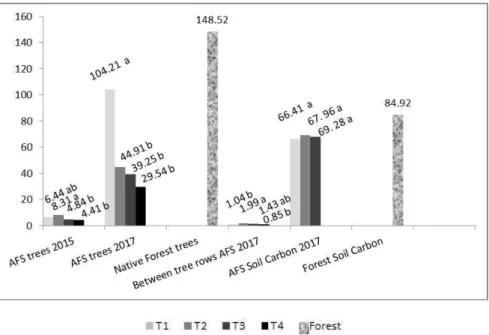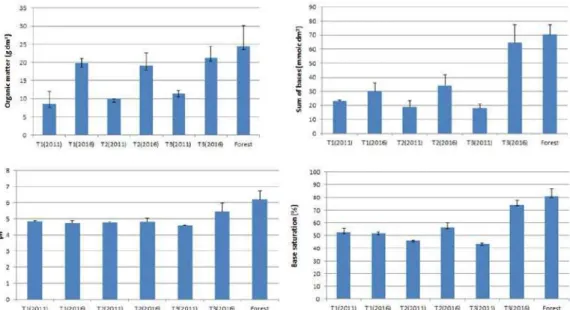AGROFORESTRY SYSTEM BENEFITS TO
ENVIRONMENT: CARBON STOCK, BIOMASS
PRODUCTION BETWEEN ROWS AND SOIL
ATTRIBUTES
Abdo MTVN1*, Siqueira CCZ2, Chiba MK2, Santos GXL1, Rotta M3, Rosa JM3, Martins ALM1, Pissarra TCT4, Fabri EG2,
Chaves TH1
(1) Polo Centro
Norte-, Agencia Paulista de Tecnologia dos Agr
Instituto Municipal de Ensino Superior IMES, Catanduva, SP, Brazil, (4) Departamento de Engenharia Rural, UNESP, Campus de Jaboticabal,SP, Brasil
*Corresponding author: mtvilela@terra.com.br
Abstract
Gully erosion stabilization started in 1997 to restore water flow and control soil erosion with four ponds construction. In 2011 an agroforestry system was planted in the edges under four treatments: T1-Mower, trees planted in hollows, spacing 3 x 2m, no plantation between rows; T2-herbicide, trees in hollows, 3.5 x 2 m, maize between; T3-Plough, harrow, scarifier, trees in furrows, 3.5 x 2 m, maize between; T4-Plough, harrow, scarifier, trees in furrows, 3.5 x 2 m, nothing between rows. Treatments influenced biomass between rows, trees carbon stock and soil properties. Trees C stock in 2015 was T1-6.4 t ha-1, T2-8.31 t ha-1, T3-4.84 t ha-1 and T4-4.41 t ha-1. In 2017 C stock was T1-104.21 t ha-1, T2-44.91 t ha-1, T3-39.2 t ha-1 and T4-29.54 t ha-1, vegetation between rows C stock was: T1-103.56 g ha-1,T2-199.11 g ha-1, T3-147.77 g ha-1 and T4-85.14 g ha-1. Also soil OM, K, P, Mg, Ca, sum of bases, CEC, pH, and base saturation at 0-20 cm increased.
Keywords: no tillage, carbon stock, tropical trees, soil attributes, Bixa orellana
Introduction
Agroforestry Systems (AFS) are important tools to restore degraded areas once they can induce the restoring process of vegetation and soil including trees to agricultural production ensuring biodiversity of the ecosystem and optimizing land use. Integrating forestry with food production and minimizing intensive land use compared to monoculture it also generates income and food production (Abdo et al. 2008). Siqueira (2017) also agrees that AFS generates extra income and allows diversified production in reforested area due to use of agricultural crops, shrub and tree species in the same physical space, with the possibility of including animal husbandry. According to the author species consortium can improve soil conditions, water quality, increase biodiversity and carbon sequestration. This crop diversification leads to a significant improvement of the physical, chemical and biological properties of the soil through nutrient cycling and erosion control. Also the use of trees can contribute significantly to reduce carbon emissions and mitigate climate change since their maintenance reduces emission of carbon as CO2 dioxide, the main source of emissions of greenhouse gases in tropical countries. According (2006) Brazil is a privileged country to reverse global climate change process by carbon sequestration through reforestation since it has climatic and technological conditions suitable for forest production but projects that measure forest related to carbon sequestration are necessary.The annatto (Bixa orellana L.) is a Bixaceae family plan, originally from tropical America, widely cultivated as a monoculture in Brazil and was used in this agroforestry system as part of the semi-arboreal component. Its seeds are valuable for producing pigments that are used as natural colorant in food, pharmaceutical and cosmetic industries with commercial value (Mendes et al. 2005). So this specie was chosen in order to optimize land and generate extra income (Fabri et al. 2015).
This restoration project took place at the Polo Regional Centro Norte-APTA a research center, . The area had no soil conservation practices and excess of runoff due to cattle tracks depth towards the water in the lower part of the area resulted in a gully with approximately 700 meters long and in some places up to 15 meters deep. To stop the erosion, four dams and four sunken ponds were built perpendicular to the erosion direction in 1997 and 1998. Each pond was connected to the next one by concrete overflows channels to prevent channel erosion and stabilize the area.
The following step to control erosion process and establish environmental sustainability was to restore the vegetation cover what was done with the implantation of a Agroforestry System in the edges of the pounds and a reforestation with native tree species in the spring.
Materials and methods
Characterization of the study area
The AFS area is in Polo Centro Norte- APTA, Pindorama, SP, Brazil. An agricultural research center with total 532 ha and 144 ha of forest. The coordinates are 48 55 'W and 21 13' S, Koeppen Aw climate (tropical rainy), altitudes from 498 to 594 m (Lepsch and Valadares 1976). It is a transition between Cerrado and Atlantic Forest biomes (IBGE 2013). The predominant land use are cane sugar, citrus, mango, guava, tomato and pasture (Cavichioli et al. 2008) and with ultisols very susceptible to erosion (Vieira et al. 1999). The restoration of riparian vegetation on the edges of the ponds was done with an agroforestry system under different managements from a minimum interference on the soil (T1) to intensive tillage and no vegetation protection (T4), planted in 2011 with four parcels with 10 rows and 7 plants. Treatments were: T1 (Mower coupled to the tractor, trees planted in hollows, spacing 3 x 2 m without cultivated or fertilization between lines); T2 (herbicide, planting in hollows, 3.5 x 2 m spacing, maize cultivated between lines); T3 (Plough, Harrow, scarifier, planting trees in furrows, 3.5 x 2 m spacing, with maize between lines); T4 (Plough, Harrow, scarifier, planting trees in furrows, 3.5 x 2 m spacing, with no plantation between lines).
Trees survey
All trees were measured in January 2015 and in 2017.The annatto also in 2014. Height was measured with graduated wooden ruler and circumference at breast height (CBH) with a graduated tape. To estimate above tree biomass an indirect method developed by ICRAF (Arevalo et al. 2002) was used and results are in tons of carbon per hectare (C t ha-1).
Biomass between rows
To determine plant biomass between rows 4 samples were taken for each treatment plot using a sample square metal with an area of 0.25 m2, randomly launched in the area. All vegetation above ground was collected and the samples were oven dried at 60 C with forced air circulation to constant mass according to Pitelli (2000).
1) were calculated for each layer by multiplying carbon content (%), soil densities (g cm-3) and layer thickness (cm), and were corrected by the Carvalho et al. (2009) method.
Results
The carbon stock for all live trees of the agroforestry system (AFS) in 2015 and 2017, the carbon stock of vegetation between trees rows in 2017 in all treatments and the value for soil carbon stock in 2017, for treatments 1, 2 and 3 are shown in Figure 1. All data is shown in tons per hectare (t ha-1).
The carbon stock of trees and soil carbon in the native forest (t ha-1) were also calculated so it can be compared to trees carbon stock from 2015 and 2017.
By September 2015 the soil organic matter and sum of bases had increased in all treatments from 2011. It was observed that soil attributes such as soil organic matter (SOM), potassium, sum of bases, phosphorus, magnesium, cation exchange capacity (CEC), pH, calcium and base saturation at the 0-20 cm depth layer also increased from the year of plantation 2011 to 2016 (Figure 2).
Figure 1: Carbon stock of trees in 2015 and 2017, carbon stock of vegetation between AFS trees rows in tons per hectare (t ha-1) in four treatments of the Agroforestry System (AFS) compared to carbon stock of native forest trees in 2017 and AFS soil carbon (t ha-1) in treatments 1, 2 and 3 compared to Forest Soil Carbon (t ha-1).
Figure 2: Soil attributes in 2011 before AFS and in 2016, compared to forest soil (Siqueira 2017).
The annatto (Bixa orellana) was also influenced by plantation techniques. Table 1 shows production and carbon stock of the specie in 2012 and 2014.
Table 1: Seeds weight (SW) in g, productive trees (PT) and total fruits (TF) in 2012, and2014 and total of living trees (LT) and Carbon stock (CS) in 2014 under four different treatments (T1, T2, T3 and T4), Variation Coefficient (VC) and General Mean (GM).
Var SW2012 SW 2014 PT 2012 PT 2014 TF 2012 TF 2014 L T 2014 C S 2014
VC% 77.04 74.53 44.71 39.33 80.56 83.96 23.53 47.07
GM 0.13 5.17 2.43 6.56 216.43 6507.53 14.41 1.46
T1 0.01b 8.2 0.62c 7.87a 20.00b 11347.5a 16.01 a 0.31 a
T2 0.14ab 5.76ab 2.37b 6.37ab 258.62a 6468.37ab 14.20 ab 0.54 a
T3 0.24 4.8ab 4.50a 8.37a 362.25a 5534ab 17.16 a 0.28 a
T4 0.13ab 1.93b 2.25b 3.62b 224.87ab 2680.25b 10.29 b 0.36 a
*Averages followed by the same letter in Colum are not statistically different (Tukey- p>0.05)
Carvalho JLN, Cerri CEP, Feigel B J, Piccolo MC, Godinho VP, Cerri CC (2009) Carbon sequestration in agricultural soils in the Cerrado region of the Brazil Amazon. Soil Till Res 103: 342-349.
Cavichioli FA et al. (2008)
http://www.cpa.unicamp.br/outras-informacoes/ clima_muni_431.html (accessed 01/06/2013).
Fabri EG, Abdo MTVN, Salazar FF, Cordeiro Junior PSC, Martins ALM, Finoto EL, Bieras AC (2016) Production and carbon stock of annatto tree in agroforestsystem, Pindorama, SP. Anais: XIV World Forestry Congress, Durban, South Africa.
IBGE (2013) IBGE Cidades. http://www.ibge.gov.br/cidadesat/painel/ painel.php?codmun=353810 (accessed 02/06/2013).
Bragantia. Campinas 35: 13-40.
Mendes MAS, Figueiredo Revista Brasileira de Sementes 27: 25-34.
economic evaluation of management alternatives in a eucalypt plantation. -420. -7. Raij B, Andrade JC, Cantarella H, Quaggio JA
Cam .
Mestrado. Campinas, IAC.
Vieira SR ( Pindorama,

